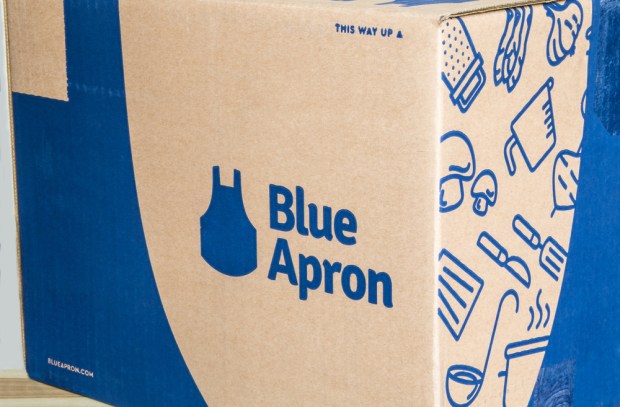Blue Apron’s Struggle To Find Meal Kit’s Secret Sauce

Meal kit commerce is having a rough time in late 2018, at least judging by recent news from Blue Apron, which is laying off employees as the company loses customers and struggles with lower average order values. Those problems reflect the industry’s general challenge of keeping hold of customers, even as companies involved in the space seek new partnerships to increase the appeal of their products and better serve the most loyal and high-spending consumer segments.
First, though, Blue Apron is seeking to rein in expenses — in this case, some $16 million — by letting go of about 100 workers, which amounts to 4 percent of the company’s workforce. The move came after an approximately 70 percent decline in the company’s stock so far this year — and as Blue Apron, which went public last year, still works to report its first-ever profit.
Most of the workers are salaried, but the layoffs apparently included no warehouse workers, with improved fulfillment operations a continuing focus of Blue Apron’s future growth plans. “These reductions included certain members of management,” CEO Brad Dickerson told analysts on Wednesday (Nov. 14) during the company’s post-earnings conference call.
News of layoffs preceded Blue Apron’s release of its third-quarter 2018 financials. Revenue decreased 28 percent year over year to $150.6 million, a decline the company blamed mostly on a decrease in customers in Q3. Net loss narrowed to $33.9 million compared with $87.2 million in the third quarter of 2017.
For Q3, Blue Apron had about 646,000 customers, down nearly 25 percent from 856,000 customers for the same period last year. Average order value also declined, to $56.79 from $58.16 in the same period last year, a drop of 2.3 percent. Orders per customers in Q3 stood at 4.1, down from 4.2. The company in the third quarter fulfilled about 2.65 million orders, down 26 percent from 3.60 million from the same period a year ago. And average revenue per customer declined nearly 5 percent in Q3, to $233 from $245.
Meal Kit Struggles
Blue Apron’s problems are part of a larger trend in the meal kit world. As recent PYMNTS research has shown via its Subscription Commerce Index, 19 percent of U.S. adults have tried a meal kit service — but only 38 percent of that group is still subscribing to those food products.
One problem?
Commitment. The PYMNTS Subscription Commerce Index found that only 9 percent of meal kit customers said they subscribed to such a service for half a year or longer. Price stands as a bit of an obstacle to subscriptions for meal kits: 49 percent of subscribers cancelled the service due to cost. A larger share, at 59 percent, said they never used a meal kit service past its trial period because of the expense.
That said, the PYMNTS research also showed that Blue Apron, one of the least expensive services available, was favored by 43 percent of respondents, followed by HelloFresh, which came in second at 33 percent. But the inescapable truth for this commerce sector is that in order to grow, meal kit subscription businesses need to retain more consumers. A service that comes with too high of a price point clearly leaves a bad taste in consumers’ mouths.
In discussing the company’s Q3 financials, Blue Apron executives talked less about pricing than about focusing more on its best customers. As those executives told analysts during the conference call, some 30 percent of Blue Apron customers account for 80 percent of revenue. That means the company will worker harder to better engage those customers rather than seek to acquire new ones who might not keep buying the meal kits, and who will not constitute a positive return on investment in a reasonable amount of time.
“Looking ahead, we intend to prioritize our best customers in all strategy decisions,” Dickerson said during that call. Signs of that are already in place with the company marketing spend. In the third quarter of 2018, marketing expense as a percentage of revenue declined to 15.4 percent from 16.3 percent in the year-ago period, with Blue Apron saying it is directing marketing to its most efficient channels and customer segments.
New Partnership
Blue Apron is also about to launch a new meal kit partnership, this one with WW, the company once branded as Weight Watchers. Earlier this year, Weight Watchers said it would roll out its own healthy meal kits in grocery stores. At the time, the move was seen as yet another challenge for Blue Apron and its rivals, who already were facing fresh challenges from Walmart, which had begun selling meal kits and “one-step meals” in some of its physical stores.
But starting in January, Blue Apron, through its digital platform, will offer products tied to WW health and diet programs, Dickerson said, a deal that could lead to the acquisition of new customers who could be more loyal than other consumer segments, given their dedication to losing weight or otherwise maintaining a healthy lifestyle. The goal, of course, is to get those new customers into that top-performing, high-volume group that accounts for most of Blue Apron’s revenue.
The upcoming Weight Watchers deal follows other recent partnerships Blue Apron has made with Grubhub (for meal kit delivery, designed to appeal to relatively last-minute eating decisions) and Jet (less of a same-day mindset than the Grubhub arrangement, designed mostly for customers looking ahead a day or two, company executives said). Both partnerships are focused on New York City, and both are in the “very early stages,” Dickerson said, without sharing any specific result of the recently launched efforts. But, he said, both deals could build the foundations for broader such efforts in other parts of the country, and provide lessons for Blue Apron’s “ability to do this ourselves.”
Going forward, Blue Apron executives said that lowering customer acquisition costs — and having more customers whose ROI will start paying back positively in a year or less — should lead the company into profitability sometime in 2019. If so, the company will have to deal with some of the meal kit headwinds, and find its sweet spot with its most dedicated consumers.
